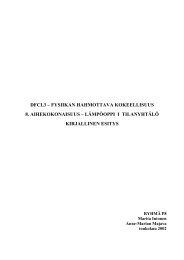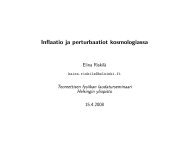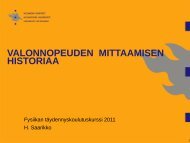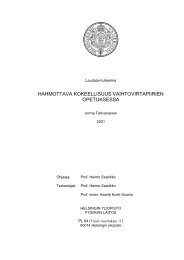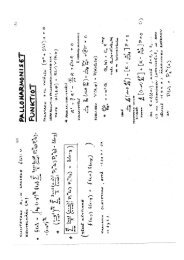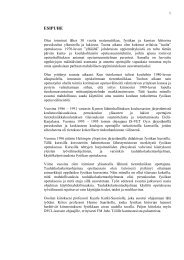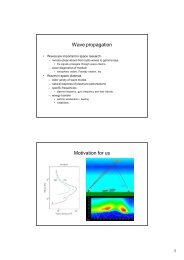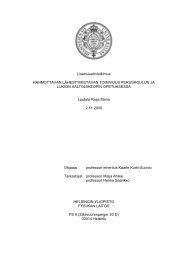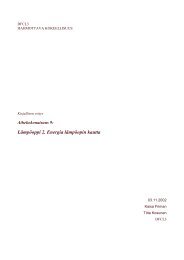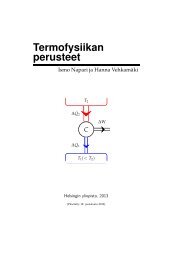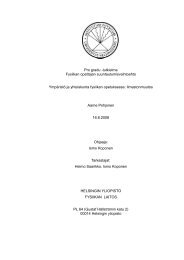Cosmological Perturbation Theory, 26.4.2011 version
Cosmological Perturbation Theory, 26.4.2011 version
Cosmological Perturbation Theory, 26.4.2011 version
You also want an ePaper? Increase the reach of your titles
YUMPU automatically turns print PDFs into web optimized ePapers that Google loves.
15 OTHER GAUGES 32We get to comoving threading by the gauge transformation ξ ′ = −v. Note that comoving threadsare usually not geodesics, since pressure gradients cause the fluid flow to deviate from free fall.The comoving gauge is defined by requiring both comoving slicing and comoving threading.ThusComoving gauge ⇔ v = B = 0. (15.7)(We assume that we are working with scalar perturbations.) The threading is now orthogonalto the slicing. We denote the comoving gauge by the sub- or superscript C. Thus the statementv C = B C = 0 is generally true, whereas the statement v = B = 0 holds only in the comovinggauge.We get to the comoving gauge from an arbitrary gauge by the gauge transformationξ ′= −vξ 0 = v − B . (15.8)This does not fully specify the coordinate system in the perturbed spacetime, since only ξ ′ isspecified, not ξ. Thus we remain free to do time-independent transformations˜x i = x i − ξ(⃗x) ,i , (15.9)while staying in the comoving gauge. This, however, does not change the way the spacetimeis sliced and threaded by the coordinate system, it just relabels the threads with differentcoordinate values x i .Applying Eq. (15.8) to the general scalar gauge transformation Eqs. (7.7,7.8,9.25,9.26,9.29),we get the rules to relate the comoving gauge perturbations to perturbations in an arbitrarygauge. For the metric:For the energy tensor:A C = A − (v − B) ′ − H(v − B) (15.10)B C = B − v + (v − B) = 0D C = − 1 3 ∇2 ξ + H(v − B)E C= E + ξψ C ≡ −R = ψ + H(v − B).δρ C = δρ − ¯ρ ′ (v − B) = δρ + 3H(1 + w)¯ρ(v − B) (15.11)δp C = δp − ¯p ′ (v − B) = δp + 3H(1 + w)c 2 s ¯ρ(v − B)δ C = δ + 3H(1 + w)(v − B)v C = v − v = 0Π C = Π.Because of the remaining gauge freedom (relabeling the threading) left by the comoving gaugecondition (only ξ ′ is fixed, not ξ), D C and E C are not fully fixed. However, ψ C is, and likewiseE C ′ = E ′ − v . (15.12)In particular, we get the transformation rule from the Newtonian gauge (where A = Φ,B = 0, ψ = D = Ψ, E = 0) to the comoving gauge. For the metric:A C = Φ − v N ′ − Hv N (15.13)R = −Ψ − Hv NE C ′ = −v N .



